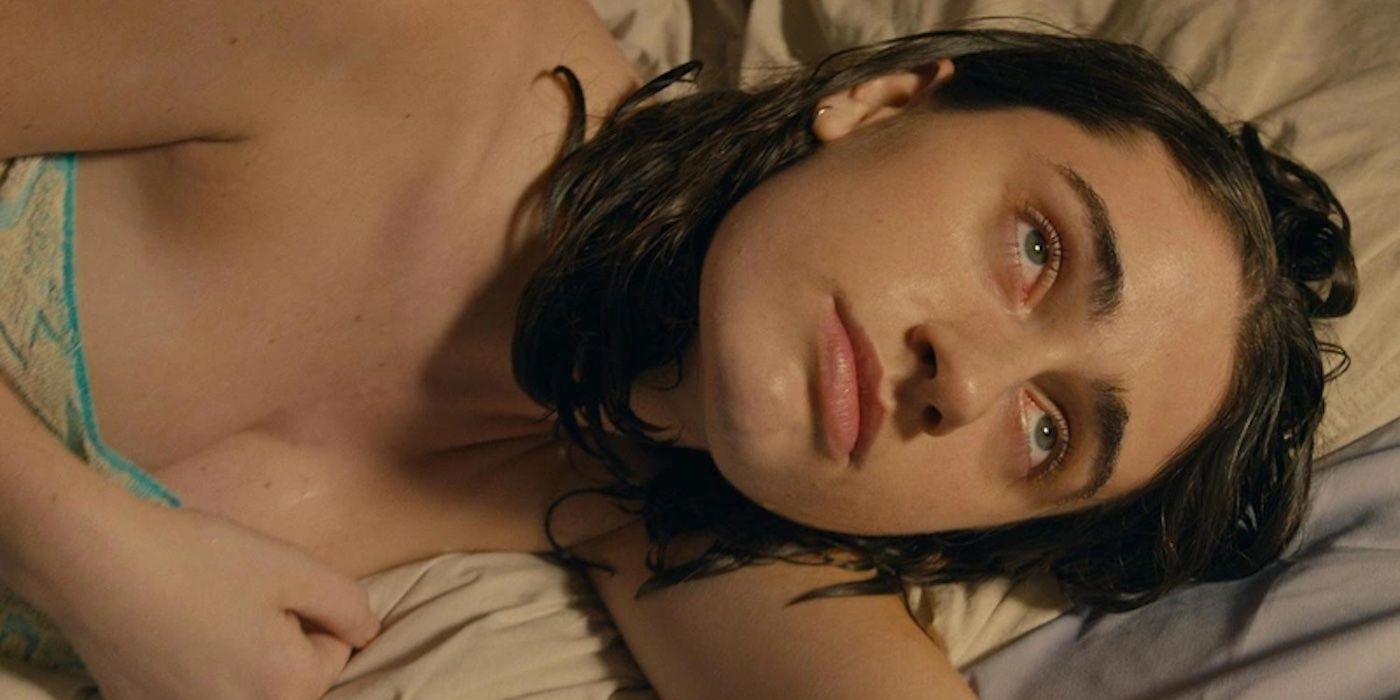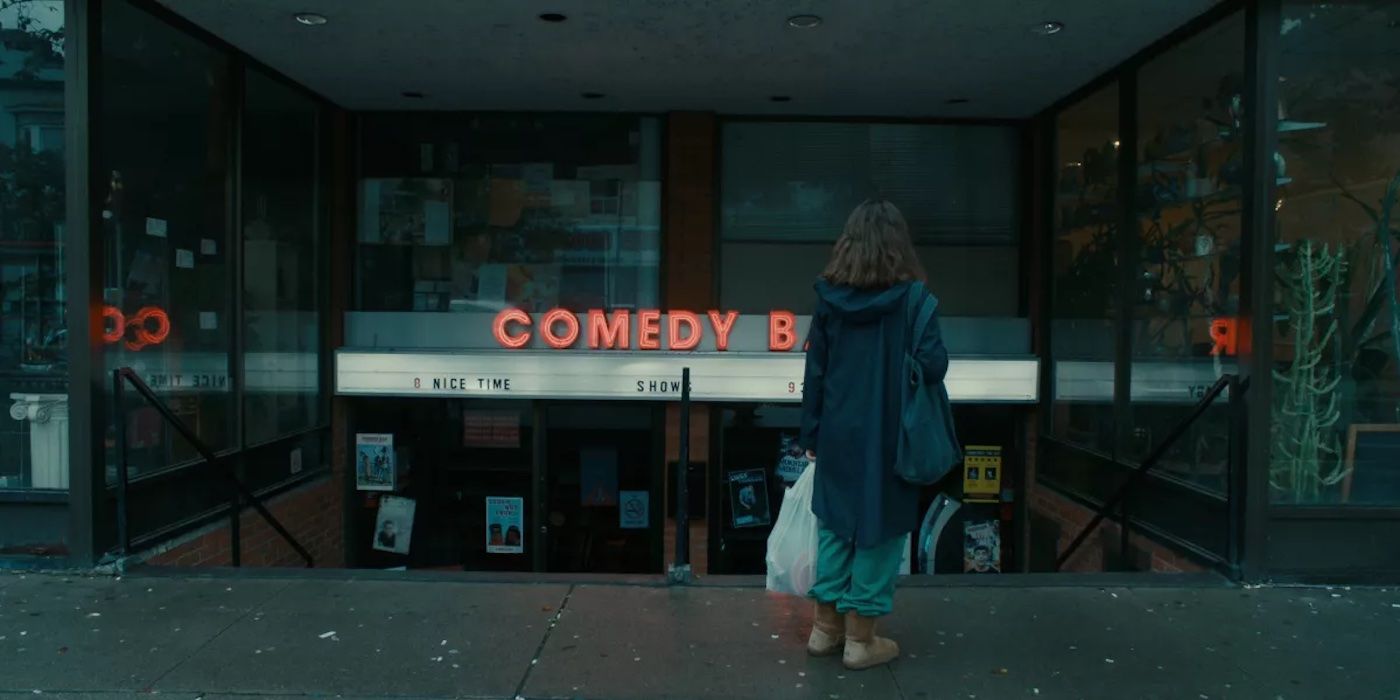Rachel Sennott is the comedic actor of the moment. In 2020, she led the anxiety-inducing, darkly hilarious Shiva Baby which put all the anxieties and fears of an entire generation on her shoulders, and she walked through it with ease. Then, last year, she stood out from an impressive cast in the horror comedy Bodies, Bodies, Bodies. Known for her pitch-perfect delivery with her elongated, American drawl and defiant stares, Sennott is quickly becoming a comedy titan for a whole new audience. Premiering at this year’s SXSW, I Used to Be Funny allows us to see a different side of the actor as she leads this shattering character study of a stand-up comic reeling from trauma and trying to repair her bond with a 14-year-old girl.
Sam (Sennott) is a relatively successful up-and-coming stand-up comedian (Sennott has a history of stand-up in real life, and it absolutely shows). She lives with her two best friends, Paige (Sabrina Jalees) and Philip (Caleb Hearon), who are also comics, and they all take their turns on stage in Toronto’s comedy scene. Things seem to be going well for her and her career, but she needs a side hustle so she takes up an au pair job for a wealthy but broken family. Brooke (Olga Petsa) is an emotionally intelligent and insightful 11-year-old whose aunt (Dani Kind) and father (Jason Jones) are doing the best they can to shield her from her mother’s terminal illness. Despite feeling too old for a “nanny,” Brooke soon warms up to her au pair as they fight over being Team Jacob or Team Edward and Sam does her best to crack her up with fresh material.
However, this isn’t where the film actually starts. Within the first few minutes, we know immediately that Sam has gone through significant trauma, but the film is in no rush to reveal to the audience what exactly happened. The beginning of the film is three years after Sam took the position with Brooke’s family, and Sam is no longer doing stand-up as she doesn't believe she’s funny anymore and menial tasks like bathing feel like climbing Everest to her. A now 14-year-old Brooke has gone missing, and Sam realizes that she might be the only person to bring her home.
I Used to Be Funny feels like a return to form for festival circuit cinema. It's a dramedy about everyday people who have dramatic things happen in their everyday life - and we get to see how they try to get through it. As mentioned before, the film’s events are kicked into motion by something awful happening to Sam, but we don't get the full picture until the last half hour. It’s because this event isn’t what’s important and the aftermath is what the film focuses on. Sam has lost sight of who she is, losing her ability to be funny like Spider-Man falling down a wall, unable to climb. The film begins with a close, tight focus on Sam, her trauma, and her healing journey. But as it progresses, the scope starts to widen and we see all the people who have been affected by what Sam went through.
It’s a modern look at friendship and support, as her friends so desperately want to be there for her but also kind of need her to help with the rent too. The film immediately places itself in the modern day. When Sam tells Paige that Brooke has gone missing, Paige tells her she needs to call the police immediately, then quickly adds “but ACAB.. obviously.” It’s reassuring to see the start of Gen-Z cinema that isn't trying to mock or make a gimmick of current trends. Shiva Baby did this to great effect as well - “I, um, don't wanna be a girlboss.” Sam, Paige, and Noah are able to make jokes about the darkest subject matter and naturally include jargon of the Internet age - “It’s giving loss.”
The film isn’t perfect, stumbling slightly when it’s making its best effort to be funny. But when it lets its incredibly talented actors do their thing, having conversations that feel authentically improvised, it flows seamlessly. Although every member of the cast gives a dynamic, layered performance, this is undoubtedly Sennott’s film. As it constantly jumps between before and after the incident, Sennott goes through all the stages of joy, determination, trauma, pain, and healing, hitting every single mark. It's a vulnerability we haven't seen her do yet, and although her other SXSW film, Bottoms, pairing her with Emma Seligman again, is sure to get more attention, this is a must-watch in her filmography, allowing her to shed some layers to give a deeply moving and emotional performance.
However, a mention has to go to the young Olga Petsa. The two have such palpable chemistry that at the end of the film, you realize that this story has really been all about their bond (interestingly, the film was originally titled "Sam & Brooke".) They fight like sisters, cutting quips about Sam’s “old” age or Brooke’s naiveté. But when the going gets rough, Sam wraps herself around Brooke as a protective guardian. The third act of the film also shows that a traumatic event does not just affect the person involved. It’s a ripple current that sends shockwaves that everyone in its wake gets knocked down by. As Petsa cuts through the dourness of the film to bring a light, innocent perspective of such a horrific situation, it makes it all the more tragic. Jalees and Hearon also add a lot of heart and warmth. When Sam is going through her most grim moments, Paige and Philip, like the comedians they are, are able to simultaneously comfort her and give her a reality check. All these perfectly placed performances form one of the most impressive ensembles you'll see this year.
This is director Ally Panwik’s feature film debut, having previously worked on TV shows such as The Great, Feel Good, and Shrill. Being a huge fan of Feel Good, I could see the director’s trademarks and motifs in both. As a director, she has a razor-sharp focus, never missing a beat in her exploration of relationships, friendships, and mental health. But there’s always a permeating levity to it, and that’s what makes I Used to be Funny such an interesting and welcome change in how we portray trauma and abuse. Panwik lets her comedic actors be comedic, but the severity of Sam’s struggle is never undercut. It results in a perfect combination of comedy and pathos, accurately reflecting the highs and lows of overcoming something as horrifying as what Sam went through. One of the most refreshing aspects is that the film isn't afraid to use comedy as a guiding light out of the dark, especially in places where other films would play it safe and keep to a more somber, serious tone.
It is a beautiful, haunting, and heartwarming look at the tidal wave that trauma brings not just to one person but their entire circle. With subtle but sharp notes on MeToo, cancel culture, online trolling, and sexual assault, I Used to Be Funny is a searingly relevant film without making that its main objective. It’s about Sam, her journey back to her hilarious self, and the unbreakable bond between two young women, but incidentally offers up a universal exploration of today’s issues. Held down by a devoted main performance and elevated by every supporting one, this film deserves all the buzz. Look out for one of the best needle drops in recent film at the very end.
Rating: B



